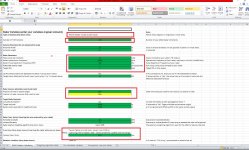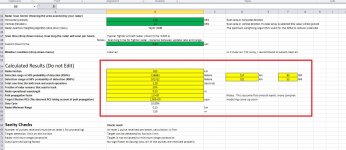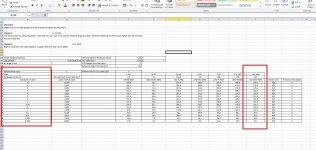Latest Thread
You are using an out of date browser. It may not display this or other websites correctly.
You should upgrade or use an alternative browser.
You should upgrade or use an alternative browser.
If you do the match with those assumptions for a 1 sqm RCS target you end up with R90%(probability of detection greater than %90) value of ~101km.
0.1 sqm @57km
0.01 sqm @32km
0,001 sqm @18km
How did you calculate?
Given the assumptions here
My rough calculation for frontal aperture suggests–
*255km range with PD=50% against 1m2 RCS target.
*170km+ range with PD=90% against 1m2 RCS target.
@Yasar_TR @Nilgiri could we say that hypothetical or lets say theoretical detection ranges of radars against different targets with differing RCS values has higly relevant but yet limited importance since capabities of your air to air missiles with far smaller and less power radars even with data link and GPS is equally important if not more important... and this area is the main play gound of low RCS targets.
@Yasar_TR @Nilgiri could we say that hypothetical or lets say theoretical detection ranges of radars against different targets with differing RCS values has higly relevant but yet limited importance since capabities of your air to air missiles with far smaller and less power radars even with data link and GPS is equally important if not more important... and this area is the main play gound of low RCS targets.
I wish to understand what are you saying. It's not clear. Could you elaborate more?
I'm none the wiser but thank you.Assumptions for X-band nose radar.
3 sqm RCS target
1552x 10 Watt modules (358x modules for cheek array)
%50 search capacity
0.03 dwell time
10 GHz frequency
If you do the match with those assumptions for a 1 sqm RCS target you end up with R90%(probability of detection greater than %90) value of ~101km.
0.1 sqm @57km
0.01 sqm @32km
0,001 sqm @18km
Cheek Array
1 sqm @46km
0.1 sqm @26km
0.01 sqm @14km
0.001 sqm @8 km
I’m not an engineer so you lost me a while back, but if you could share some formula it could help with the understanding bit
It's the fourth root formula.

Fourth Roots Calculator
Calculate the fourth root of numbers. 4th root calculator. Free online calculators for radicals, exponents, math, fractions, factoring, plane geometry, solid geometry, algebra, finance and more. Calculator roots.
Let's say, If you detect 1m2 RCS target at 100km, then you will detect a 0.1m2 RCS target at 56km.
And a 0.01m2 RCS target at 31km, a 0.001m2 RCS target at 18km and so on.
Last edited:
Your calculation is wrong.How did you calculate?
Given the assumptions here
View attachment 68549
My rough calculation for frontal aperture suggests–
*255km range with PD=50% against 1m2 RCS target.
*170km+ range with PD=90% against 1m2 RCS target.
This is a very rough way to calculate.It's the fourth root formula.

Fourth Roots Calculator
Calculate the fourth root of numbers. 4th root calculator. Free online calculators for radicals, exponents, math, fractions, factoring, plane geometry, solid geometry, algebra, finance and more. Calculator roots.www.calculatorsoup.com
Let's say, If you detect 1m2 RCS target at 100km, then you will detect a 0.1m2 RCS target at 56km.
View attachment 68579
And a 0.01m2 RCS target at 31km, a 0.001m2 RCS target at 18km and so on.
I use the AESA Radar Calculator for my calculations.
Your calculation is wrong.
How is my calculation wrong? Could you show the math? It would be easier for me to catch the fault.
This is a very rough way to calculate.
This is the formula. No exceptions. See your results and my results are same if we use the 100km against 1m2 RCS target as reference.
Sorry, can't download it.
Google AESA radar range calculator. The latest version should be V3. It is an Excel spreadsheet.How is my calculation wrong? Could you show the math? It would be easier for me to catch the fault.
This is the formula. No exceptions. See your results and my results are same if we use the 100km against 1m2 RCS target as reference.
Sorry, can't download it.
You are wrongHow is my calculation wrong? Could you show the math? It would be easier for me to catch the fault.
This is the formula. No exceptions. See your results and my results are same if we use the 100km against 1m2 RCS target as reference.
Sorry, can't download it.
Here I found it.
AESACalcStable-ReleaseV3.xlsx
 drive.google.com
drive.google.com
Bro, the chart you shared only demonstrate my calculation. Considering everything remains same, (transmission power, dwell time, duty cycle/pulse repetition frequency,) if an AESA has 226km against 3m2 target with PD=90% like and then it will have 170+km range against 1m2 target with PD=90%. (As demonstrated with the deep Bue line on the top.)
There is a funny way to describe it
226/172 =1.31
Now guess the fourth root of 3.
Last edited:
I'm not sharing a chart. I'm sharing an Excel file. You should download it and fill out the Excel spreadsheet with the above assumptions to get a solution. You don't know what you are talking about. I highlighted the areas you should look for and fill. I don't know how i can help you anymore. You seem to lack basic knowledge.
Attachments
I'm not sharing a chart. I'm sharing an Excel file. You should download it and fill out the Excel spreadsheet with the above assumptions to get a solution. You don't know what you are talking about. I highlighted the areas you should look for and fill. I don't know how i can help you anymore. You seem to lack basic knowledge.
Lol, no. I do know what I am talking about. And you don't need to highlight the areas. I do know and understand all of those criteria. Right now I am outside and on my phone. I will use this Excel file when I get to my PC.
But that's irrelevant. Your result sheet shows 133km for 3m² RCS target. Except that wasn't the reference in the infographic .
the reference point is 226km (PD=90%) against 3m² RCS target. Which is I explicitly used for my calculation. Given this reference point, 170km against 1m² target is still correct.
You could've just said, your AESA calculator (given all those values) gives a different results altogether than the one cited in the infographic. Instead you are insulting me.
Last edited:
I don't care about the orange and yellow ranges given. The infographic clearly states assumptions about the radar and ranges should be calculated from those not the other way around. It is not right to achieve a result from another result if the first result is not true. Those assumptions are as follows.Lol, no. I do know what I am talking about. And you don't need to highlight the areas. I do know and understand all of those criteria. Right now I am outside and on my phone. I will use this Excel file when I get to my PC.
But that's irrelevant. Your result sheet shows 133km for 3m² RCS target. Except that wasn't the reference in the infographic .
View attachment 68596
the reference point is 226km (PD=90%) against 3m² RCS target. Which is I explicitly used for my calculation. Given this reference point, 170km against 1m² target is still correct.
You could've just said, your AESA calculator (given all the all those values) gives a different results altogether than the one cited in the infographic. Instead you are insulting me.
-Co-altitude
-10W modules 1552x modules
-%50 Search capacity
-0.03 seconds dwell time
-10 GHz frequency
-1 microsecond pulsewidth
Someone probably calculated for 100 W per module and ended up with those ranges. There is a thing called sanity check. There is no way to achieve said ranges with 10 W mini modules.
I don't care about the orange and yellow ranges given. The infographic clearly states assumptions about the radar and ranges should be calculated from those not the other way around. It is not right to achieve a result from another result if the first result is not true. Those assumptions are as follows.
-Co-altitude
-10W modules 1552x modules
-%50 Search capacity
-0.03 seconds dwell time
-10 GHz frequency
-1 microsecond pulsewidth
Someone probably calculated for 100 W per module and ended up with those ranges. There is a thing called sanity check. There is no way to achieve said ranges with 10 W mini modules.
I just used the calculator. It's a good one. I see in your calculation you assumed pulse repetition frequency to be at 100kHz. Which isn't given in the inforgraphic. Afaik, N036 Belka is liquid cooled. Hence it shouldn't be restricted to 100kHz PRF. If we increase the PRF to 300kHz while keeping all the other perimeters same as you mentioned, calculator gives a range of 169km against 1m2 target and 222km (PD=90%) against 3m2 target. Almost the same range as cited in the infographic. (Wihtout increasing the transmission power from 10w to 100w per module)
(Radar handbook 3rd Edition)
Last edited:
So you are saying Russian radar has equal PRF to Western radars? I would love to see the Russian oscillator that enables above 100 kHz PRF. IMHO even the 100 kHz assumption is overestimation for the Russian hardware. For comparison Korean AESA radar will have 150 kHz max PRF. By the way higher PRF means more ambiguity even if Russians come up with a 300 kHz PRF radar they won't have enough signal processing capability to make use of it. In fact we directly see the results of those things in the field. I would put Russian radars at least 1 generation, more likely 2 generation behind the Western radars.I just used the calculator. It's a good one. I see in your calculation you assumed pulse repetition frequency to be at 100kHz. Which isn't given in the inforgraphic. Afaik, N036 Belka is liquid cooled. Hence it shouldn't be restricted to 100kHz PRF. If we increase the PRF to 300kHz while keeping all the other perimeters same as you mentioned, calculator gives a range of 169km against 1m2 target and 222km (PD=90%) against 3m2 target. Almost the same range as cited in the infographic. (Wihtout increasing the transmission power from 10w to 100w per module)
View attachment 68597
(Radar handbook 3rd Edition)
SSB officially launched the national oscillator project early this year after Aselsan and Asartech made a breakthrough. R&D studies matured enough so SSB turned it into an official project.

SSB 14 yeni Ar-Ge projesi başlattı | SavunmaSanayiST
Savunma Sanayii Başkanlığı tarafından 14 yeni Ar-Ge Projesi başlatıldı. Ar-Ge Projeleri İmza Töreni, Savunma Sanayii Başkanlığı'nda gerçekleştirildi.
 www.savunmasanayist.com
www.savunmasanayist.com
Low phase noise dielectric resonator oscillator development project (DRO)
Low phase noise crystal oscillator development project ( Kristal Osilatör)
Last edited:
So you are saying Russian radar has equal PRF to Western radars? I would love to see the Russian oscillator that enables above 100 kHz PRF. IMHO even the 100 kHz assumption is overestimation for the Russian hardware. For comparison Korean AESA radar will have 150 kHz max PRF. By the way higher PRF means more ambiguity even if Russians came up with a 300 kHz PRF radar they won't have enough signal processing capability to make use of it. In fact we directly see the results of those things in the field. I would put Russian radars at least 1 generation, more likely 2 generation behind the Western radars.
This is a good point. Yes, higher RPF requries higher processing power. But can't they use off the shelf chips? Even low cost old APG-80 developed in 2002 can increase RPF up to 200kHz, according to the paper I read. Anyway, you are probably right.
On a side note, if we are not using the assumptions from infographic, then by increasing the pulsewidth N36 can compensate and extend the detection range while keeping the PRF same. Albeit it would sacrifice some accuracy.
SSB officially launched the national oscillator project early this year after Aselsan and Asartech made a breakthrough. R&D studies matured enough so SSB turned it into an official project.
(3:38)

SSB 14 yeni Ar-Ge projesi başlattı | SavunmaSanayiST
Savunma Sanayii Başkanlığı tarafından 14 yeni Ar-Ge Projesi başlatıldı. Ar-Ge Projeleri İmza Töreni, Savunma Sanayii Başkanlığı'nda gerçekleştirildi.www.savunmasanayist.com
Low phase noise dielectric resonator oscillator development project (DRO)
Low phase noise crystal oscillator development project ( Kristal Osilatör)
That is very interesting. I thought Alelsan got all the neccessary components covered already. If national crystal oscillator is still in development, which ones Aselsan using in its products?
BARBAROS-MLU
{#ElectroOptical}
PİRİ 100 Infrared Search and Track System
.
ASELSAN
{#ElectroOptical}
PİRİ 100 Infrared Search and Track System
.
ASELSAN








